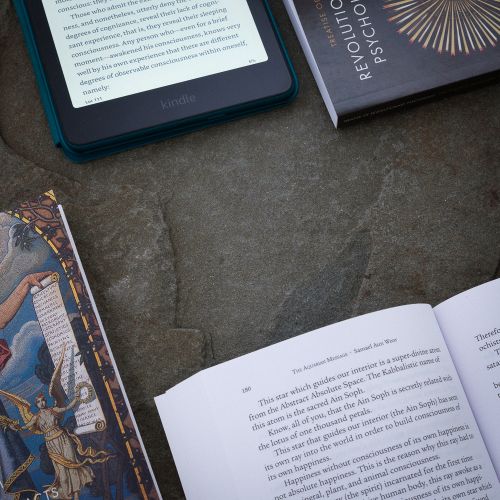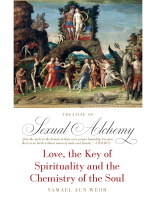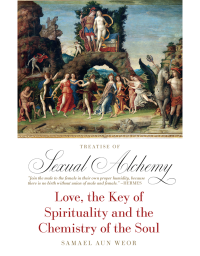Alchemy, the secret art of the land of Khem [Egypt], is one of the two oldest sciences known to the world. The other is astrology. The beginnings of both extend back into the obscurity of prehistoric times. According to the earliest records extant, alchemy and astrology were considered as divinely revealed to man so that by their aid he might regain his lost estate. According to old legends preserved by the Rabbins, the angel at the gate of Eden instructed Adam in the mysteries of Qabbalah [the Tree of Life], and of alchemy [the Tree of Knowledge], promising that when the human race had thoroughly mastered the secret wisdom concealed within these inspired arts, the curse of the forbidden fruit would be removed and man might again enter into the Garden of the Lord. As man took upon himself “coats of skins” (physical bodies) at the time of his fall, so these sacred sciences were brought by him into the lower worlds incarnated in dense vehicles, through which their spiritual transcendental natures could no longer manifest themselves. Therefore they were considered as being dead or lost.
The earthly body of alchemy is chemistry, for chemists do not realize that half of The Book of Torah is forever concealed behind the veil of Isis (see the Tarot), and that so long as they study only material elements they can at best discover but half of the mystery. Astrology has crystallized into astronomy, whose votaries ridicule the dreams of ancient seers and sages, deriding their symbols as meaningless products of superstition. Nevertheless, the intelligentsia of the modern world can never pass behind the veil which divides the seen from the unseen except in the way appointed--the Mysteries.
What is life? What is intelligence? What is force? These are the problems to the solution of which the ancients consecrated their temples of learning. Who shall say that they did not answer those questions? Who would recognize the answers if given? Is it possible that under the symbols of alchemy and astrology lies concealed a wisdom so abstruse that the mind of this race is not qualified to conceive its principles?
The Chaldeans, Phœnicians, and Babylonians were familiar with the principles of alchemy, as were many early Oriental races. It was practiced in Greece and Rome; was the master science of the Egyptians. Khem was an ancient name for the land of Egypt; and both the words alchemy and chemistry are a perpetual reminder of the priority of Egypt’s scientific knowledge. According to the fragmentary writings of those early peoples, alchemy was to them no speculative art. They implicitly believed in the multiplication of metals; and in the face of their reiterations both the scholar and the materialist should be more kindly in their consideration of alchemical theorems. Evolutionists trace the unfoldment of the arts and sciences up through the growing intelligence of the prehistoric man, while others, of a transcendental point of view, like to consider them as being direct revelations from God.
Many interesting solutions to the riddle of alchemy’s origin have been advanced. One is that alchemy was revealed to man by the mysterious Egyptian demigod Hermes Trismegistus. This sublime figure, looming through the mists of time and bearing in his hand the immortal Emerald, is credited by the Egyptians as being the author of all the arts and sciences. In honor of him all scientific knowledge was gathered under the general title of The Hermetic Arts. When the body of Hermes was interred in the Valley of Ebron (or Hebron), the divine Emerald was buried with it. Many centuries afterward the Emerald was discovered--according to one version, by an Arabian initiate; according to another, by Alexander the Great, King of Macedon. By means of the power of this Emerald, upon which were the mysterious inscriptions of the Thrice Great Hermes--thirteen sentences in all--Alexander conquered all the then known world. Not having conquered himself, however, he ultimately failed.

The difficulty in deciding the origin of alchemy is directly due to ignoring the lost continent of Atlantis. The Great Arcanum was the most prized of the secrets of the Atlantean priestcraft. When the land of Atlas sank, hierophants of the Fire Mystery brought the formula to Egypt, where it remained for centuries in the possession of the sages and philosophers. It gradually moved into Europe, where its secrets are still preserved intact.

Regardless of its originator, it was left to the Egyptian priests to preserve alchemy for the modern world. Egypt, because of the color of its earth, was called “the black empire” and is referred to in the Old Testament as “the land of darkness.” By reason of its possible origin there, alchemy has long been known as “the black art,” not in the sense of evil but in the sense of that darkness which has always enshrouded its secret processes.
During the Middle Ages, alchemy was not only a philosophy and a science but also a religion. Those who rebelled against the religious limitations of their day concealed their philosophic teachings under the allegory of gold-making. In this way they preserved their personal liberty and were ridiculed rather than persecuted.
Alchemy is a threefold art, its mystery well symbolized by a triangle. Its symbol is 3 times 3--three elements or processes in three worlds or spheres. The 3 times 3 is part of the mystery of the 33rd degree of Freemasonry, for 33 is 3 times 3, which is 9, the number of esoteric man and the number of emanations from the root of the Divine Tree. It is the number of worlds nourished by the four rivers that pour out of the Divine Mouth as the verbum fiat. Beneath the so-called symbolism of alchemy is concealed a magnificent concept, for this ridiculed and despised craft still preserves intact the triple key to the gates of eternal life. Realizing, therefore, that alchemy is a mystery in three worlds--the divine, the human, and the elemental--it can easily be appreciated why the sages and philosophers created and evolved an intricate allegory to conceal their wisdom.
Alchemy is the science of multiplication and is based upon the natural phenomenon of growth. “Nothing from nothing comes,” is an extremely ancient adage. Alchemy is not the process of making something from nothing; it is the process of increasing and improving that which already exists. If a philosopher were to state that a living man could be made from a stone, the unenlightened would probably exclaim, “Impossible!” Thus would they reveal their ignorance, for to the wise it is known that in every stone is the seed of man. A philosopher might declare that a universe could be made out of a man, but the foolish would regard this as an impossibility, not realizing that a man is a seed from which a universe may be brought forth.
God is the “within” and the “without” of all things. The Supreme One manifests Himself through growth, which is an urge from within outward, a struggle for expression and manifestation. There is no greater miracle in the growing and multiplication of gold by the alchemist than in a tiny mustard seed producing a bush many thousands of times the size of the seed. If a mustard seed produces a hundred thousand times its own size and weight when planted in an entirely different substance (the earth), why should not the seed of gold be multiplied a hundred thousand times by art when that seed is planted in its earth (the base metals) and nourished artificially by the secret process of alchemy?
Alchemy teaches that God is in everything; that He is One Universal Spirit, manifesting through an infinity of forms. God, therefore, is the spiritual seed planted in the dark earth (the material universe). By arc it is possible so to grow and expand this seed that the entire universe of substance is tinctured thereby and becomes like unto the seed--pure gold. In the spiritual nature of man this is termed regeneration; in the material body of the elements it is called transmutation. As it is in the spiritual and material universes, so it is in the intellectual world. Wisdom cannot be imparted to an idiot because the seed of wisdom is not within him, but wisdom may be imparted to an ignorant person, however ignorant he may be, because the seed of wisdom exists in him and can be developed by art and culture. Hence a philosopher is only an ignorant man within whose nature a projection has taken place.
Through art (the process of learning) the whole mass of base metals (the mental body of ignorance) was transmuted into pure gold (wisdom), for it was tinctured with understanding. If, then, through faith and proximity to God the consciousness of man may be transmuted from base animal desires (represented by the masses of the planetary metals) into a pure, golden, and godly consciousness, illumined and redeemed, and the manifesting God within that one increased from a tiny spark to a great and glorious Being; if also the base metals of mental ignorance can, through proper endeavor and training, be transmuted into transcendent genius and wisdom, why is the process in two worlds or spheres of application not equally true in the third? If both the spiritual and mental elements of the universe can be multiplied in their expression, then by the law of analogy the material elements of the universe can also be multiplied, if the necessary process can be ascertained.
That which is true in the superior is true in the inferior. If alchemy be a great spiritual fact, then it is also a great material fact. If it can take place in the universe, it can take place in man; if it can take place in man, it can take place in the plants and minerals. If one thing in the universe grows, then everything in the universe grows. If one thing can be multiplied, then all things can be multiplied, “for the superior agrees with the inferior and the inferior agrees with the superior.” But as the way for the redemption of the soul is concealed by the Mysteries, so the secrets for the redemption of the metals are also concealed, that they may not fall into the hands of the profane and thereby become perverted.







